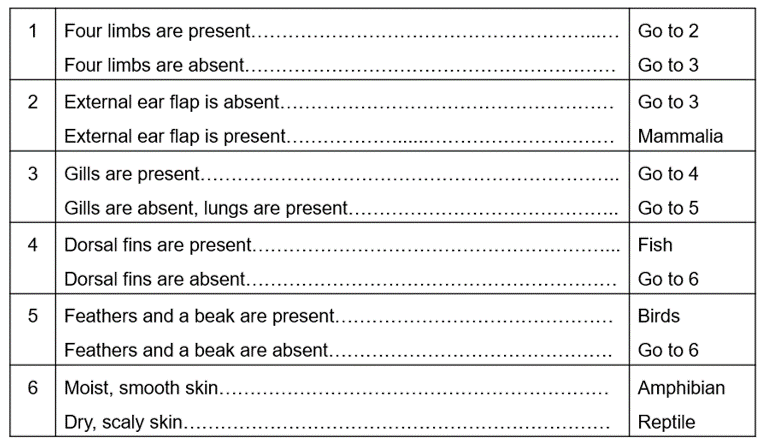a)
The gray wolf (Canis lupus ) and the coyote (Canis latrans ) are both predators occurring across large parts of North America. Coyotes are smaller than gray wolves and its diet consists of a variety of smaller prey animals, such as hares, rodents, birds and reptiles, while gray wolves hunt larger prey such as deer, elk and moose.
State the genus and species name of the gray wolf and the coyote.
[2 marks]
Assess your score
View Answer
b)
Organisms are grouped into different taxonomic groups, the largest of which is known as the domain.
Identify the domain to which the gray wolf and coyote belong to.
[1 mark]
Assess your score
View Answer
c)
List two features of all organisms that belong to the domain identified in part b).
[2 marks]
Assess your score
View Answer
d)
The grouping of the gray wolf and coyote is an example of natural classification which can be challenging to carry out accurately.
State one technological development that has enabled natural classification to be done more accurately.
[1 mark]
Assess your score
View Answer
Next Question
a)
Study the following diagram showing some features of specimen A .
Use the dichotomous key below to identify the class that specimen A belongs to.
[1 mark]
Assess your score
View Answer
b)
Specimen A is classified by using a natural classification system.
Define the term 'natural classification'.
[2 marks]
Assess your score
View Answer
c)
Natural classification can be very useful in conducting research in the field of biodiversity.
List two advantages of natural classification systems.
[2 marks]
Assess your score
View Answer
d)
Sometimes developments in cladistics will lead to the reclassification of organisms.
State one example of reclassification.
[1 mark]
Assess your score
View Answer
Previous Question Next Question
a)
The following diagram shows an organism that belongs to the phylum Cnidaria .
i)
State the type of symmetry that is demonstrated by this organism.
[1 mark]
ii)
List one other visible feature that is unique to phylum Cnidaria .
[1 mark]
Assess your score
View Answer
b)
The phylum Cnidaria includes a wide range of different organisms.
List two examples of organisms that would belong to this phylum.
[2 marks]
Assess your score
View Answer
c)
State the way in which the organism shown in the diagram at part a) would be able to obtain food.
[1 mark]
Assess your score
View Answer
Previous Question Next Question
a)
Study the following cladogram showing the evolutionary relationship between different mammalians.
Identify the mammalians that are the most closely related according to this cladogram.
[1 mark]
Assess your score
View Answer
b)
State the purpose of the nodes in the cladogram.
[2 marks]
Assess your score
View Answer
c)
Identify the mammalian group that were the first to branch off and form an independent group from the others.
[1 mark]
Assess your score
View Answer
Previous Question Next Question
One mark is available for clarity of communication throughout this question.
a)
State the conventions that should be used when writing binomial names.
[3 marks]
Assess your score
View Answer
b)
Differences in the base sequences of DNA and amino acid sequences of proteins can be used by scientists as a molecular clock.
Outline how differences in the base sequences of DNA can be used as a molecular clock.
[3 marks]
Assess your score
View Answer
c)
Coniferophytes are commonly known as conifers and are usually tall trees.
List the main features of Coniferophytes.
[7 marks]
Assess your score
View Answer
Previous Question



